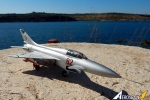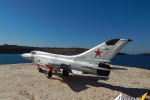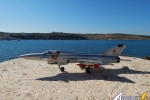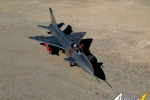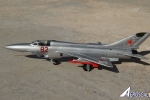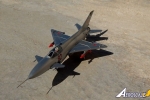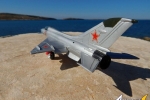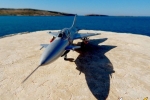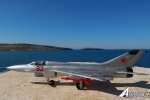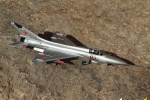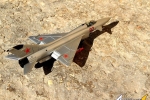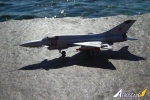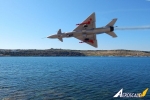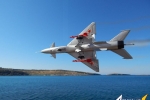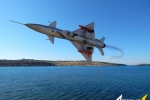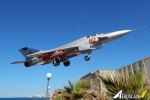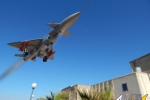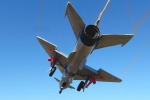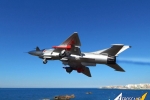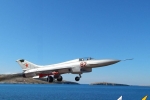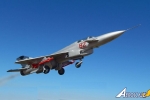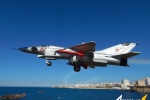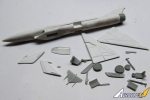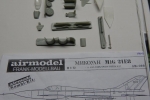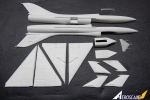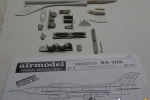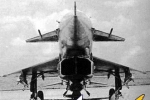1⁄72МиГ e-8
2
Comments
History
There was a time back in early 60s when the Mikoyan OKB attempted to improve the standard fighter plane of those days, the MiG-21F Fishbed C which was a fast Mach 2 fighter but with some short comings as weak armament, insufficient electronic equipment, poor endurance and range.The further development took two different tracks. One was the prototype e-7, the other was prototype e-8/e-8A. With the intention to solve all problems, the e-8 had a radical change in design of the aircraft. The air intake was replaced to lower fuselage so that an additional fuel tank to the fuselage could be installed, meaning more range, and a bigger more efficient and possibly an all weather radar equipment could be fitted in the nose. Manoeuvrability could be improved by use of Canard-wings which in the e-8 these were standard equipment.
Little is known as to when and why the e-8 project was discarded and may not be correct to suppose that technical problems led to the cancellation of the project. The most likely supposition is that the radical change in design on an already introduced standard fighter gave rise to delay in the production during the tense years of the early 60s era.
It was then decided that the prototype MiG-21 PF (Fishbed D) was chosen to be the successor and was produced and introduced into service, where the classical line of the Mig fighter design remained unaltered.
The e-8 was built as an aerodynamic test aircraft with folding ventral fin, canards and ventral intakes. The fairly short career of the E-8 could be possibly due to problems related to the R-21 F-300 engine which was known to fail during flight.
The Kit
Airmodel issued the vac-form kit of the e-8 complete with resin detail parts. The major components are the fuselage parts, wings and tail planes which all come in white vac-form styrene. Other parts like the landing gear legs, ventral strakes, canard wings, cockpit seat and coaming, instrument panel,back plate, wheel doors, and rear exhaust outlet are all in dark green resin. In addition there is a single vac form clear canopy . The instruction sheet contains a good three view scale plan and two photos of the e-8 and e-8A are included along with assembly instructions.Surface detail of the vac parts is good and smooth with inset panel lines and under fuselage air brakes are also detailed. No decal sheet included and a red outlined yellow number is suggested to go on fuselage cockpit side along with star positions.
Construction
The first stage of construction is assembling the cockpit office most of which is resin parts, adding instruments and effectively paint the interior in light turquoise with seat in different grey, adding crew figure and so on. There are no side consoles but with good reference one can put some representation although the cockpit is quite crammed and little could be observed when the crew figure is added. As for the seat I preferred to replace it with an injected one from a surplus Tamiya MiG-21 series. I also added lead weight to the rear of cockpit.Sanding down the fuselage halves should not be overdone or else the cockpit assembly would be too proud to go in it. Care should be taken when assembling the ventral air intake which has a central dividing web. This is the only practically delicate stage as it is assembled in a sagged configuration as per side views. The joining surface needed a little filler.
Surface detail on fuselage and wings was mildly scored then masked as a protection during sanding of excess filler. I also added little detail to wheel wells which were boxed with plastic card. The gear legs are quite detailed particularly the nose wheel and the wheel tyres all had a flattened part detail. I drilled a shallow dowel hole to take the legs. Flaps were cut and fixed lowered adding actuators to each. Two small rectangular air intake ducts were also added to rear of fuselage. The rear engine resin part added in the end.
Colour and markings.
This is the ideal model for those who would like to try some of the specialist natural metal finishes. I have used a mix of commercial silver mixed with little clear lacquer and this seemed to give an effective metal finish. Cockpit interior was light turquoise. Decals came from spares box with suitable red stars and a red identification nose number.Conclusion
Obviously this is a model mainly for those with interest in exotic Russian aircraft types. The end result certainly gives the impression of the modern day fighter type in spite that it was being developed circa 1962. Adding two dummy under-wing Atoll missiles made it looks all the more formidable.Comments
Very nicely done Carmel and a very interesting article. Great photos. I think the Soviets should have continued the development of the e8. In the end I believe the e8 would have been a superior aircraft to the MIG-21.
MAY 10, 2014 - 09:16 PM
I certainly agree with you Burt that the MiG-21 E8 could have emerged into a super Mig. Exact reason why project was shelved may never be known.A project shrouded in secrecy may give rise to speculations.
MAY 13, 2014 - 06:29 AM
Copyright ©2021 by Carmel John Attard. Images also by copyright holder unless otherwise noted. The views and opinions expressed herein are solely the views and opinions of the authors and/or contributors to this Web site and do not necessarily represent the views and/or opinions of AeroScale, KitMaker Network, or Silver Star Enterrpises. Images also by copyright holder unless otherwise noted. Opinions expressed are those of the author(s) and not necessarily those of AeroScale. All rights reserved. Originally published on: 2014-05-10 02:37:43. Unique Reads: 5438





